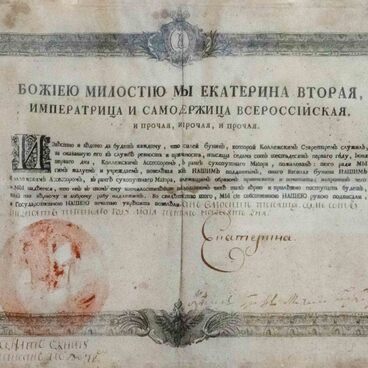The photograph presented at the exhibit shows 20-year-old Ivan Bunin who lived in Oryol in 1890. The picture shows the writer in burka and black ‘noble’ cap with a red band, which, according to Bunin himself, was ‘very pretty’.
Bunin wrote about this photo to his beloved Varvara Pashchenko: ‘I am sending the card, but it seems to be bad – it does not look like me, in my opinion, although everyone says the opposite… I took foppishly. Really? And then – this idiotic burka is utterly irrelevant, to a frock coat and a white tie’. The writer left another photo from these series to his sister Maria Bunina. On the back, he left an inscription:
‘In Peirosh’s photography
In a little dandified taste
I was in a picture, – and good
I was handsome, Musia…
I’m not like that in nature:
– I am not in the flower of beauty…
After all, I am your dear brother
And I look just like you!..
I. Bunin
For memory to dear Musinka. March 21, 1891. Picture was taken in September of 1890’.
Vera Muromtseva, his second wife, wrote about this photograph of Bunin later: ‘In the portrait in burka… he is very handsome and young… The artist Parkhomenko, who lived in Oryol at that time, told me when we met that Ivan Alekseevich had very beautiful thick hair and that he wanted to make portrait of him. I don’t remember if he made a portrait of him. Ivan Alekseevich hated posing and refused even famous artists.’ Bunin himself recalled that in his youth “I had romantic eyes, so blue, dreamy. And a soft fluff on my cheeks, so I was sometimes took for a young Jew. I wore a double satin tie from Pushkin”s time”.
From 1889 to 1892 Ivan Bunin lived in Oryol and worked in the editorial office of the provincial newspaper “Oryol Vestnik”. It was in Oryol where he began his professional literary career: not only served as a correspondent, but also published poetry, short stories and essays. Bunin sent his works both to his dear “Oryol Vestnik” and to the capital publications as well. The classic recalled: “While working in “Oryol Vestnik” I wrote in fits and starts, publishing in “Severnyi Vestnik”, “Nabliudatel” and illustrated magazines and published the first book of poetry’.
Bunin wrote about this photo to his beloved Varvara Pashchenko: ‘I am sending the card, but it seems to be bad – it does not look like me, in my opinion, although everyone says the opposite… I took foppishly. Really? And then – this idiotic burka is utterly irrelevant, to a frock coat and a white tie’. The writer left another photo from these series to his sister Maria Bunina. On the back, he left an inscription:
‘In Peirosh’s photography
In a little dandified taste
I was in a picture, – and good
I was handsome, Musia…
I’m not like that in nature:
– I am not in the flower of beauty…
After all, I am your dear brother
And I look just like you!..
I. Bunin
For memory to dear Musinka. March 21, 1891. Picture was taken in September of 1890’.
Vera Muromtseva, his second wife, wrote about this photograph of Bunin later: ‘In the portrait in burka… he is very handsome and young… The artist Parkhomenko, who lived in Oryol at that time, told me when we met that Ivan Alekseevich had very beautiful thick hair and that he wanted to make portrait of him. I don’t remember if he made a portrait of him. Ivan Alekseevich hated posing and refused even famous artists.’ Bunin himself recalled that in his youth “I had romantic eyes, so blue, dreamy. And a soft fluff on my cheeks, so I was sometimes took for a young Jew. I wore a double satin tie from Pushkin”s time”.
From 1889 to 1892 Ivan Bunin lived in Oryol and worked in the editorial office of the provincial newspaper “Oryol Vestnik”. It was in Oryol where he began his professional literary career: not only served as a correspondent, but also published poetry, short stories and essays. Bunin sent his works both to his dear “Oryol Vestnik” and to the capital publications as well. The classic recalled: “While working in “Oryol Vestnik” I wrote in fits and starts, publishing in “Severnyi Vestnik”, “Nabliudatel” and illustrated magazines and published the first book of poetry’.



